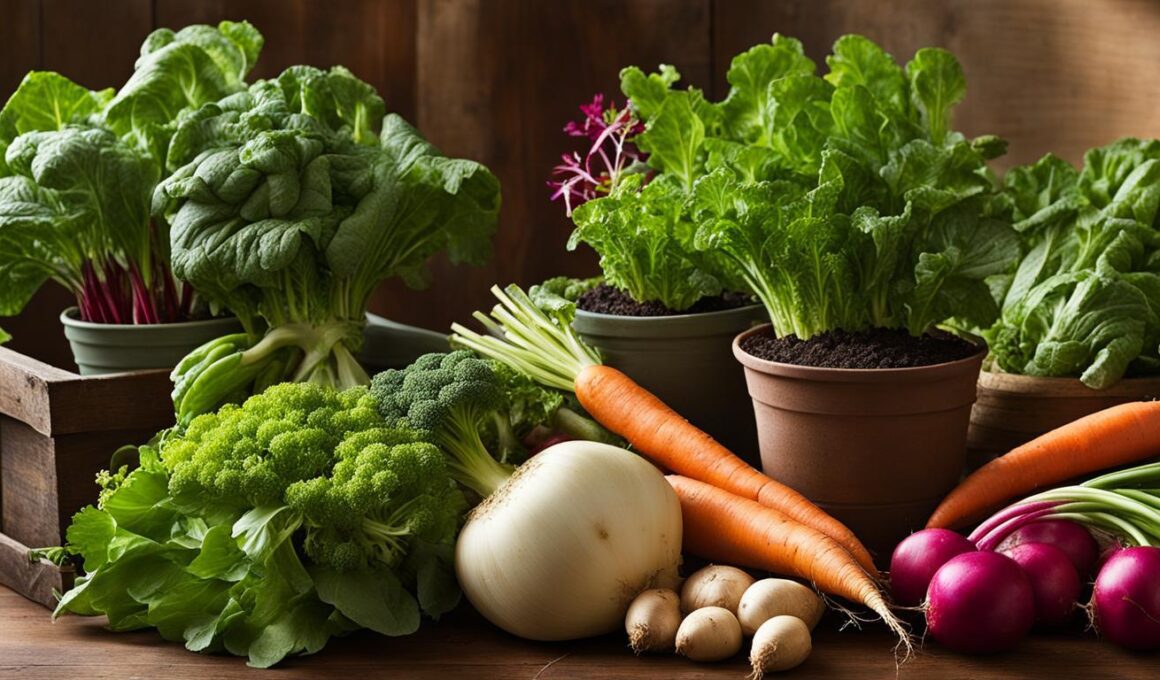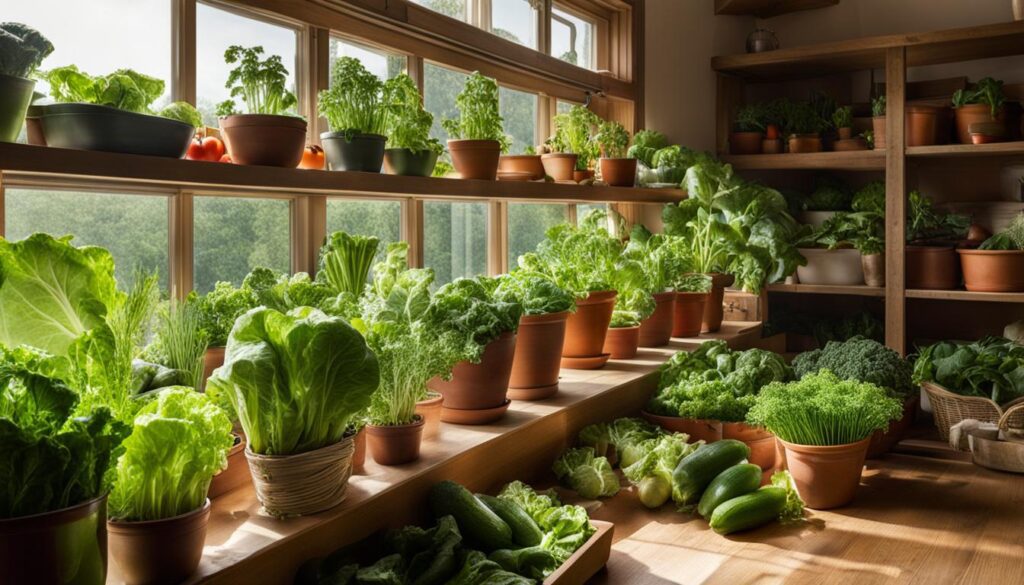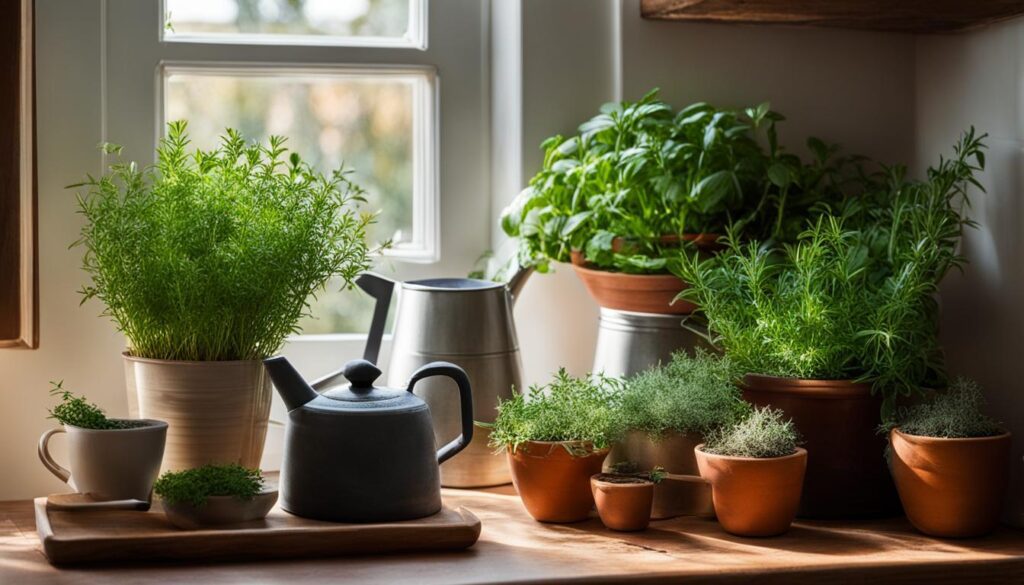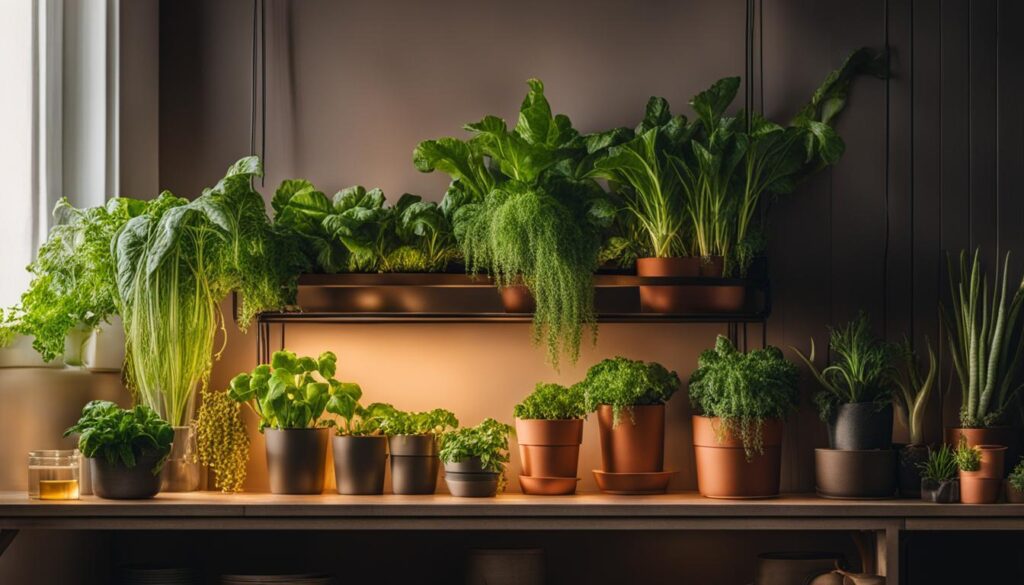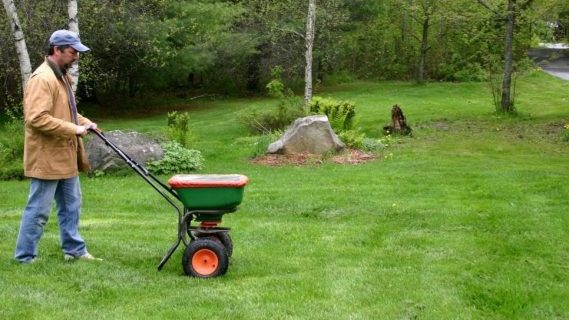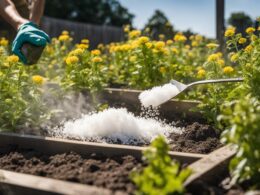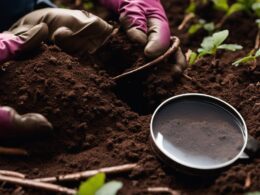Did you know that you can grow a wide variety of vegetables indoors during the winter months, regardless of whether you have a garden or live in a cold climate? By using pots and seeds, you can easily create your own indoor vegetable garden and enjoy a fresh harvest all year round. Let’s explore the vegetables that thrive in indoor conditions, and learn how you can have a bountiful winter garden right in your own home.
Key Takeaways:
- Growing vegetables indoors is possible even in winter.
- Pots and seeds are the key tools you need to start your indoor vegetable garden.
- There is a wide variety of vegetables that can be successfully grown indoors.
- Creating an indoor garden allows you to enjoy fresh produce throughout the year.
- Start your own indoor vegetable garden today and savor the taste of homegrown vegetables!
Growing Vegetables Indoors: 37 Edibles You Can Grow In The Winter
When it comes to growing vegetables indoors during winter, the options are plentiful. With pots and seeds, you can create your own indoor vegetable garden and enjoy fresh produce all year round. Let’s take a look at a variety of vegetables that thrive in indoor conditions and are perfect for your winter garden.
Tomatoes, squash, cucumbers, bell peppers, hot peppers, and herbs like basil, parsley, and rosemary are just a few examples of vegetables that can be successfully grown indoors. Leafy greens such as spinach, kale, lettuce, and Swiss chard also thrive in indoor environments, along with root vegetables like carrots. With this diverse range of options, you can have a bountiful harvest even during the winter months.
To provide you with a comprehensive list, here are 37 vegetables that can be grown indoors during winter: tomatoes, squash, cucumbers, bell peppers, hot peppers, basil, parsley, spinach, kale, lettuce, rosemary, chives, thyme, catnip, sprouts, turnips, carrots, potatoes, wheatgrass, parsnip, asparagus, beet, Jerusalem artichoke, celeriac, rhubarb, arugula, green beans, mandarin orange, avocado, mushrooms, mint, ginger, radishes, scallions, cilantro, and garlic greens.
| Vegetables | Indoor Growing Requirements |
|---|---|
| Tomatoes | Unglazed pots, proper airflow, good drainage |
| Squash | Pots with 12-inch depth, 24-inch diameter |
| Cucumbers | Large pots with climbing structures, 73-79°F temperature |
| Bell Peppers | Soil mix of vermiculite, peat moss, and coarse sand, 65-75°F temperature, direct sunlight |
| Hot Peppers | Similar requirements as bell peppers, smaller pots |
| Herbs | Plastic or clay pots, well-draining potting soil, adequate sunlight, regular watering |
| Leafy Greens | Plastic or terra-cotta pots, nutrient-rich potting soil, ample sunlight or artificial light, regular watering |
| Root Vegetables | Pots with 8-inch depth, consistently damp soil, adequate space for growth |
So, whether you have a small space or live in a cold climate, growing vegetables indoors during winter is a viable option. With the right techniques and proper care, you can enjoy a constant supply of fresh, homegrown produce. Start your indoor vegetable garden today and savor the taste of nutritious vegetables all year long.
Tips for Growing Tomatoes, Squash, and Cucumbers Indoors in Winter
Growing vegetables indoors during the winter months is a fantastic way to enjoy fresh produce regardless of the weather outside. In this section, we will explore some essential tips and techniques for successfully growing tomatoes, squash, and cucumbers indoors in winter. Whether you are a seasoned indoor gardener or just starting out, these tips will help you maximize your harvest and enjoy the taste of homegrown vegetables all year round.
Growing Tomatoes Indoors
Tomatoes are a popular choice for indoor gardening, and with the right conditions, you can enjoy a bountiful crop. Start by selecting compact tomato varieties that are well-suited for indoor cultivation, such as Toy Boy, Tiny Tim, Florida Petite, or Red Robin. These varieties are perfect for small spaces and containers. Opt for unglazed pots that provide proper airflow and good drainage for your tomato plants. Place the pots near a south-facing window or use grow lights to ensure they receive at least 6 to 8 hours of sunlight each day. Maintain a consistent temperature between 65 and 75°F and water the plants regularly, allowing the soil to dry slightly between waterings.
Growing Squash Indoors
Squash plants, like crookneck or butternut squash, can also thrive indoors during winter. Choose compact varieties that are well-suited for container gardening. When selecting pots, opt for ones with a depth of about 12 inches and a diameter of 24 inches to accommodate the roots. Fill the pots with well-draining potting soil and place them near a south-facing window or under grow lights. Squash plants require a temperature range of 60 to 75°F for optimal growth. Water the plants regularly, keeping the soil moist but not waterlogged. As the plants grow, provide support with stakes or trellises to prevent them from sprawling on the ground.
Growing Cucumbers Indoors
Cucumbers can be successfully grown indoors during winter, provided they have the right growing conditions. Choose cucumber varieties specifically bred for indoor cultivation, as they are more compact and require less space. Use large pots with a climbing structure for the plants to grow vertically. Cucumbers need plenty of sunlight, so place them near a south-facing window or use grow lights to provide at least 8 hours of light each day. Maintain a temperature between 73 and 79°F to promote healthy growth. Water the plants regularly, ensuring the soil remains evenly moist. As the cucumbers develop, provide support for their vines to climb, such as tomato cages or trellises.
By following these tips, you can successfully grow tomatoes, squash, and cucumbers indoors during the winter months. Experiment with different varieties and techniques to find what works best for you. Enjoy the process of nurturing your plants and look forward to a bountiful harvest of fresh, homegrown vegetables.
Growing Bell Peppers, Hot Peppers, and Herbs Indoors During Winter
Growing your own bell peppers, hot peppers, and herbs indoors during the winter can be a rewarding and flavorful experience. With a little bit of planning and care, you can enjoy the taste and aroma of these fresh ingredients all year round. Here are some tips and techniques to help you successfully grow bell peppers, hot peppers, and herbs indoors during the winter months.
Growing Bell Peppers Indoors
Bell peppers are a versatile and nutritious vegetable that can be easily grown indoors. To start, choose varieties that are well-suited for indoor cultivation, such as Miniature Red, Yolo Wonder, or Purple Beauty. Fill a pot with a mix of vermiculite, peat moss, and coarse sand in equal proportions to provide the right growing medium. Place the pot in a location that receives at least 6-8 hours of direct sunlight per day. Water the plants regularly, making sure the soil is moist but not waterlogged. Maintain a temperature range of 65 to 75°F for optimal growth. With proper care, you can enjoy a bountiful harvest of bell peppers throughout the winter.
Growing Hot Peppers Indoors
If you enjoy adding a spicy kick to your dishes, growing hot peppers indoors is a great option. Start by selecting hot pepper varieties that are well-suited for indoor cultivation, such as Jalapeno, Thai Chili, or Cayenne. Use smaller pots compared to bell peppers, as hot pepper plants don’t require as much space. Ensure that the pots have good drainage to prevent waterlogging. Place the pots in a sunny location, ideally near a south-facing window or under grow lights. Hot peppers thrive in warm temperatures, so maintain a temperature range of 70 to 80°F for optimal growth. With consistent care and attention, you can enjoy a fiery harvest of hot peppers even during the coldest months of winter.
Growing Herbs Indoors
Fresh herbs can elevate the flavor of any dish, and growing them indoors during the winter is a convenient way to have them on hand. Popular herbs like basil, parsley, rosemary, chives, thyme, and mint can be easily grown indoors. Choose small pots with drainage holes and fill them with well-draining potting soil. Place the pots in a sunny location or under grow lights, ensuring that the herbs receive at least 4-6 hours of direct sunlight per day. Water the herbs regularly, allowing the soil to dry out slightly between waterings. With proper care, you can enjoy a continuous supply of fresh herbs throughout the winter, adding a burst of flavor to your culinary creations.
Growing Leafy Greens and Root Vegetables Indoors in Winter
When it comes to growing your own vegetables indoors during the winter, leafy greens and root vegetables are excellent choices. Not only are they relatively easy to grow, but they also provide you with fresh and nutritious produce right at your fingertips. Let’s explore how you can successfully cultivate leafy greens and root vegetables in the comfort of your own home.
Leafy Greens
Leafy greens such as spinach, kale, lettuce, and Swiss chard thrive in indoor environments. To get started, choose plastic or terra-cotta pots that are large enough to accommodate the root systems of these plants. Fill the pots with a nutrient-rich potting soil and make sure they have good drainage. Place them in a sunny spot, either near a south-facing window or under grow lights, to ensure they receive adequate sunlight. Regularly water the plants, keeping the soil consistently damp but not waterlogged. With proper care, you’ll soon be enjoying homegrown leafy greens all winter long.
Root Vegetables
Growing root vegetables like carrots indoors is easier than you might think. Select pots with a depth of at least 8 inches to allow enough space for the roots to develop. Consider varieties such as Little Fingers Carrots or Paris Market Carrots, which are well-suited for indoor cultivation. Fill the pots with a well-draining potting soil and sow the seeds according to the package instructions. Make sure to water the plants regularly, keeping the soil moist but not saturated. With patience and care, you’ll be rewarded with crisp and flavorful root vegetables that are perfect for winter cooking.
| Vegetable | Recommended Varieties | Container Size | Sunlight Requirements | Watering Needs |
|---|---|---|---|---|
| Spinach | Savoy or Baby Spinach | 12-inch pot | 6-8 hours of sunlight per day or grow lights | Keep soil consistently damp |
| Kale | Red Russian or Lacinato | 12-inch pot | 6-8 hours of sunlight per day or grow lights | Keep soil consistently damp |
| Lettuce | Butterhead or Romaine | 10-inch pot | 4-6 hours of sunlight per day or grow lights | Keep soil consistently damp |
| Swiss Chard | Rainbow or Fordhook | 12-inch pot | 6-8 hours of sunlight per day or grow lights | Keep soil consistently damp |
| Carrots | Little Fingers or Paris Market | 8-inch pot | 6-8 hours of sunlight per day or grow lights | Keep soil consistently moist |
With a little bit of planning and care, you can enjoy a bountiful harvest of leafy greens and root vegetables even during the winter months. So why not start your own indoor vegetable garden today and savor the goodness of homegrown produce all season long?
Are Indoor Winter Vegetables Able to Withstand Cold Temperatures?
Indoor winter vegetables play a crucial role in providing fresh produce during the colder months. Their ultimate vegetable cold hardiness allows them to withstand low temperatures, making them ideal for indoor cultivation. With proper care and attention, these resilient plants can thrive in a controlled indoor environment, offering a sustainable source of greens all winter long.
Conclusion
The winter season is no obstacle to growing your own vegetables. With the right techniques and a little bit of care, you can have fresh, homegrown produce right at your fingertips. Whether you choose to grow tomatoes, squash, cucumbers, bell peppers, herbs, leafy greens, or root vegetables, the possibilities are endless.
So, roll up your sleeves, gather your pots and seeds, and start your own indoor vegetable garden today. Enjoy the taste of fresh, nutritious vegetables all year round!
FAQ
What vegetables can be grown indoors in winter?
You can grow a wide variety of vegetables indoors during the winter months, including tomatoes, squash, cucumbers, bell peppers, hot peppers, basil, parsley, spinach, kale, lettuce, rosemary, chives, thyme, catnip, sprouts, turnips, carrots, potatoes, wheatgrass, parsnip, asparagus, beet, Jerusalem artichoke, celeriac, rhubarb, arugula, green beans, mandarin orange, avocado, mushrooms, mint, ginger, radishes, scallions, cilantro, and garlic greens.
How do you grow tomatoes, squash, and cucumbers indoors in winter?
Tomatoes can be grown indoors using unglazed pots for proper airflow and good drainage. Squash plants, such as Crookneck or butternut squash, can be grown in pots with a depth of about 12 inches and a diameter of 24 inches. Cucumbers specially created for indoor growth are recommended and need large pots with climbing structures. Adequate sunlight and temperatures between 73 and 79°F are necessary for successful cucumber cultivation.
Can bell peppers, hot peppers, and herbs be grown indoors during winter?
Yes, bell peppers and hot peppers can be grown indoors in pots. Bell peppers require a soil mix of vermiculite, peat moss, and coarse sand in equal proportions for optimal growth. They require a constant temperature of 65 to 75°F and direct sunlight. Hot peppers have similar requirements but can be grown in smaller pots. Herbs like basil, parsley, rosemary, chives, thyme, and mint can also be successfully grown indoors in plastic or clay pots. They require well-draining potting soil, adequate sunlight, and regular watering.
What are the best vegetables to grow indoors for leafy greens and root vegetables?
Leafy greens, including spinach, kale, lettuce, and Swiss chard, can be easily grown indoors in plastic or terra-cotta pots. They require a nutrient-rich potting soil, ample sunlight or artificial light, and regular watering. Root vegetables like carrots can also be grown indoors in pots with a depth of at least 8 inches. Varieties like Little Fingers Carrots and Paris Market Carrots are suitable for indoor cultivation. Maintaining consistently damp soil and providing adequate space for growth are crucial for successful root vegetable cultivation.





